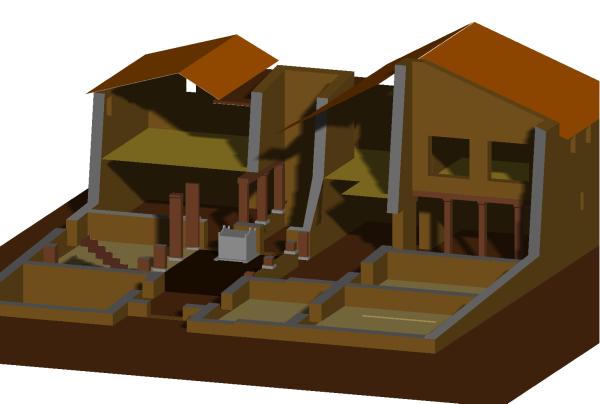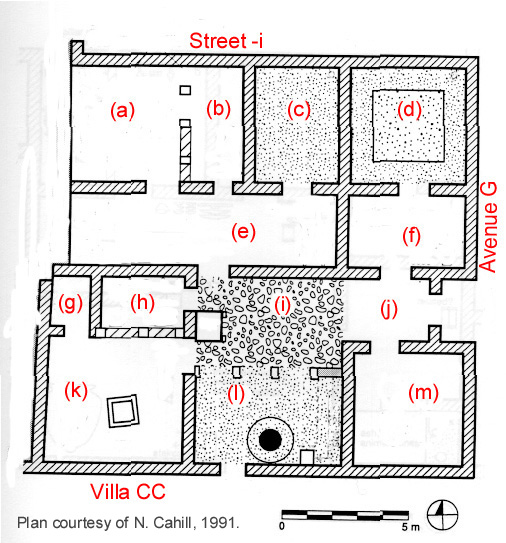

The House of Many Colors
The House of Many Colors, the most famous of the approximately 100 excavated homes in Olynthus, is located in the southeast section of the Villa 6. A square, two-story home of 17 meters length on each side, the House of Many Colors is known for the brightly painted walls and floors in the dwelling 6. The House most likely is dated between the late 5th and early 4th centuries B.C 7.
Two characteristics make this house particularly important to the study of ancient Greek homes. First, the House of Many Colors is considered fairly typical for a wealthy, “pastas-style” villa in the region 1: the home was square, approximately 17 meters across, divided into halves with the northern half further divided into quarters, and semi roofed on the north end, with rooms centered around the central courtyard and pastas 7.
Second, the unique history of Olynthus has allowed for the excellent preservation of homes like the House of Many Colors within a specific time frame. At approximately 432 B.C. Olynthus was formed from the consolidation of several towns for military reasons (the Chalcidian people of Olynthus were enemies of Athens leading up to the Peloponnesian War) 2,3 Thucydides, a 5th century Greek historian, writes:
"Perdiccas at the same time persuaded the Chalcidians to abandon and pull down their cities on the sea-coast and settle inland at Olynthus, making there a single strong city. . . . And so they proceeded to dismantle their cities, move inland, and prepare for war." 3
When the Chalcidians restored peace with Athens almost a century later, they angered the king of Macedon, who was still enemies with the city state. When the king’s half brothers tried to take the throne from him and hid in Olynthus, the king destroyed the city. The town was less than one hundred years old, creating a very clean window of archaeological evidence for historians 1.
Rooms
Courtyard (i)
The courtyard was both central in location and in focus for the Greek home. In addition to work and social activities, the courtyard was the place where religious activities took place. In the House of Many Colors, archaeologists have found a canopy-covered altar on the west side. The courtyard was often the largest room in the house (book). Because this particular courtyard was tiny (3.6 by 5.9 meters) with few finds, it was probably not used to the same extent as the average Greek courtyard. In addition to the altar, a storage amphora, askos, seven loomweights, hardware, and spikes from woodwork were discovered in the area. 1
Pastas (e)
The pastas was a covered courtyard used for domestic activities and religious ritual. 1,7. The pastas in The House of Many Colors was more covered than usual 7. Archaeological discoveries here include two portable altars, a marble louter, storage amphora, table vases, iron bosses, and iron spikes 1.
Kitchen (k,g,h)
The kitchen complex was comprised of three rooms. The largest room contained a hearth used for heating the home. The second room, “the flue,” was used as a broiling pit, a place to throw away ashes, and storage. In this room, archaeologists found a pit filled with bones of various animals, including cow, sheep, goats, pigs, and deer 1. In addition, there were spit supports, vases, harware, terracottas, loomweights, askoi, plates, amphoras, saucers and various other trinkets. The smallest room most likely contained a bathtub and was used for cooking, bathing, and storage. 1 Interestingly, no actual bathtub was found in this room 7. Archaeological finds here include storage amphoras, loomweights, saucers, coins, arrowheads, bowls, grindstones, olpe, pelike, and lamps.
Suite (a,b)
Suite a, b was most likely a kitchen or a women’s workroom 1. Room a was roofed, and b was partially roofed 7. Most likely used for weaving, scientists have found loomweights, epinetron, spindle whorl, tale vases, terracotta female head, protome, fine vases, and cups. Suite a, b was unique because it was preserved in the middle of a renovation: amphoras with sand and pigments, pigment grinders, and mosaic pebbles were found here.
Mystery Room (c)
The purpose of room c is uncertain, although archaeologists have speculated that it was used for socializing or as a bedroom 7. The room was well-decorated in a similar fashion to suites a and b and contained hardware, coins, bronze fragments, a pithos, and a catchbasin.
Andron (d)
The andron was a room used primarily for dining and socializing. This room received its name because male visitors were often sent here (book It contained a cement floor with a raised platform of .9 meters width along the sides of the room. These platforms served to separate diners from meal waste, which was usually thrown on the floor 2. Seven dining couches were placed on the platforms. In the room, two iron spearheads were found 7.
Anteroom (f)
Archaeologists found bronze decorative bosses, a fishplate, plates, and a krater in this room 1.
Exhedra (l)
The exhedra and court were adjacent and divided by a colonnade 7. The exhedra served as an alternative pastas in the house. A deep pit was found on one end that my have been an unfinished cistern 7.
Storeroom (m)
The storeroom was used primarily for agricultural products. It is likely that these inhabitants sold these products. A pithoi was found. In the House of Many Colors, the floor in this room was approximately one meter below the surrounding rooms 1.
Second Floor
It is very likely that this house had a second floor. Unfortunately the lack of a floorplan prevents us from understanding the second floor. It is speculated that this floor contained the bedrooms of the house since there were few on the lower floor. We suspect the house had a second story because of the existence of pillars, a rubble foundation on one side o the house that hints at staircase remains, a light well, pillar partitions in the kitchen complex, and fragments of a mosaic floor found in the exhedra. It is possible that the upper floors were for use mainly by women: a litigant states, “My little house is divided into a ground and an upper floor, partitioned in the same places; the lower rooms are for men’s use and he upper for women’s use…” (Lysias I, 9) 2.
